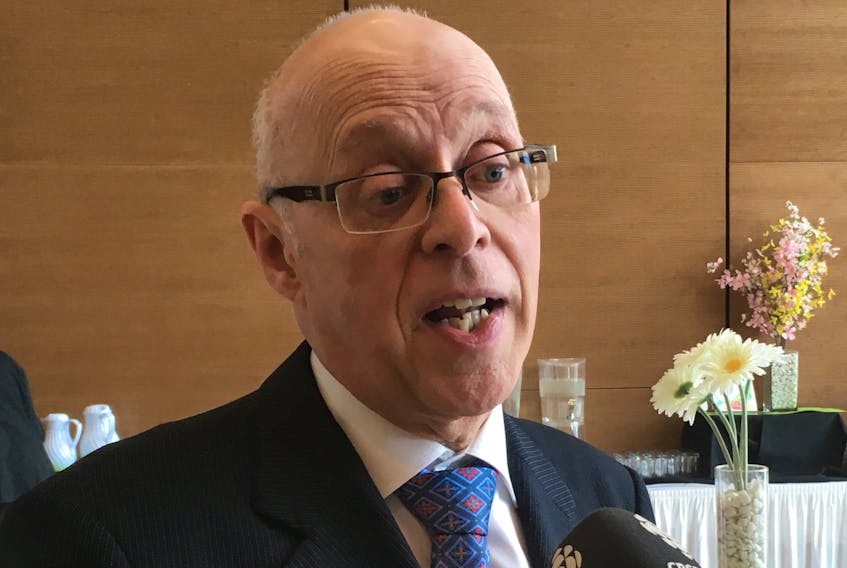During a forum on health care outcomes and costs in St. John’s on Wednesday, there were references to road bumps, barriers, elephants in the room and, more than once, the Titanic.
Despite the anecdotes, the event — subtitled “What can we afford?” — revealed optimism exists even now, when it comes to the potential for improvements in the health care system without breaking the bank.
The daylong event offered high-profile speakers from the government and medicine, all giving their thoughts on the short- and long-term. They took questions from the audience — a mix of patients, medical professionals and administrators.
Health care accounts for 38 to 40 per cent of the province’s spending, reaching $3 billion in 2017.
Provincial Health Minister Dr. John Haggie said, of that, the vast majority is for managing illness, versus health.
In Newfoundland and Labrador, he said, 62 per cent of people have at least one chronic disease, versus 53 per cent of all Canadians. And while 38 per cent of the people here live with two chronic diseases, just 29 per cent of people in the country report the same.
Haggie referenced the province’s rapidly aging population atop that — set to surpass the other Atlantic provinces.
“The biggest rate of (cost) increase is, in actual fact, in pharmaceuticals,” he told reporters. “We have had some savings, particularly this last year, with a new generic arrangement that has essentially been able to offset our known increases for next year.”
Canada is a small part of the global drug market, but the Haggie said national pharmacare offers the potential to help, if done right. A review is on tap nationally and talks between the province and federal government continue.
“The biggest single item, quite frankly, is salaries,” Haggie said, on system costs. “Over the last 10 years, we’ve had very little increase in hours worked — I think it’s been about three, maybe three and a half, per cent. But over that 10-year period we’ve seen a 30-plus per cent increase in the cost of those hours.”
More nurses
Debbie Forward, president of the Registered Nurses’ Union of Newfoundland and Labrador, representing the largest group of health care providers, proposed hiring more RNs, adding salaries to the books. She promised there would be savings overall if the government made the move.
Forward said bringing in full-time positions and reducing casual contracts would help avoid cancelled medical procedures due to a lack of nursing staff.
With more RNs available, she suggested, the government can reduce overtime costs and the use of “sick” days — days she openly acknowledged are now being used by some staff to secure personal time, given existing OT demands and interruptions to approved leave.
“Last year, over 1,200 (RN) shifts were greater than 16 hours,” she said, describing the demands, reaching into 24-hour shifts.
Apart from more full-time RNs, Forward proposed the province consider placing RNs in schools, providing more early intervention for mental health and addictions in youth. It could avoid acute care costs down the line, she suggested, while allowing for promotion of changes in diet and exercise levels, reducing chronic illness rates.
Whatever is done to tackle existing issues, she said any significant changes — particularly in public health indicators — will take time and require co-operation of all parties in the system.
“There is absolutely no magic bullet,” she said about keeping health care costs in check.
Concerned about cuts
Dr. Lynn Dwyer, president of the Newfoundland and Labrador Medical Association (NLMA), said she would like to see a multi-year plan from the provincial government on health care spending, giving some indication as to where cuts might be made (or programs “trimmed”) if required in the coming years.
While the province has recently held its health care budget steady, she said, that still amounts to change, given new service demands based on population needs, equipment replacements and new technologies.
Steve Gillingham, president of the Pharmacists’ Association of Newfoundland and Labrador, said there are things people can do right away to help support the public system in this environment.
For one, he said, people often mix up medications or fail to follow the directions with their prescriptions — such as finishing a round of antibiotics — leading to additional drug costs, fresh doctor visits and new admissions.
Multiple health care providers mentioned patients being unable to tell them what medications they were taking and why, even when holding their pill bottles or prescriptions in hand.
Gillingham said 67 per cent of Canadians take more than five medications a day, making mix-ups a real, practical challenge.
Regarding overprescribing, College of Physicians and Surgeons Newfoundland and Labrador registrar Dr. Linda Inkpen said the regulatory body has followed up on complaints and spoken with physicians over the years, when anecdotes or reports were brought to them by other health care providers.
Inkpen highlighted the new provincial prescription monitoring program, targeting potentially inappropriate prescribing of opioids, and suggested it should be able to, down the line, offer more data on other drugs, allowing more follow-up. That includes antibiotics prescriptions.
Basic access to data, she said, just numbers, offer new possibilities to improve the system.
Haggie also spoke about data, and technology, saying new ways for patients to access health records or for administrators to track patient flow through the system have the potential to save time and money.
He said the ability for records to be compiled and move efficiently within the system relies a lot on the IT infrastructure, the “backroom architecture,” where there is still need for spending into the future. Haggie said he has estimates placing the “IT deficit” in the $50-million to $150-million range, with need to be sure what you’re installing will be appropriate in the long-term.
In terms of what spending might come with the next budget, there was mention of an impending announcement on the Waterford Hospital, but no other details revealed.
More information is available online, through CARE at MUN, Collaborative Applied Research on Economics, at https://www.mun.ca/care/.









